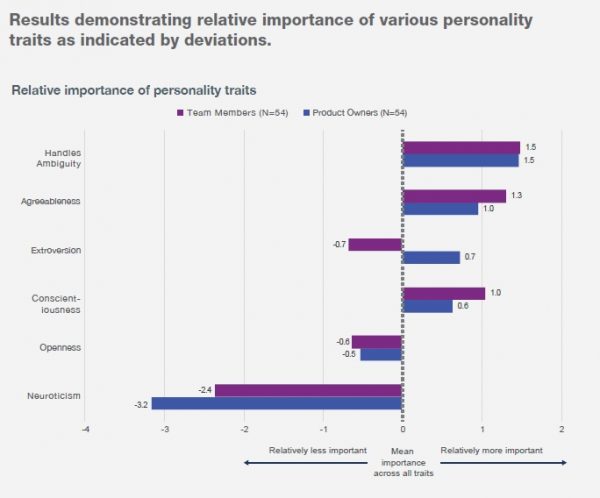Is hiring for an Agile team (team member, scrummaster or product owner) different than hiring for a software development organization that follows another approach? Scrum.org and McKinsey & Company have recently published the results of a joint study exploring the values and traits that make agile teams successful. The goal of this document is to help and guide organizations with concepts and ways to better recruit and coach their teams.
Scrum.org and McKinsey & Company joint study was conducted in 2018. The study looks at the personality traits and work values in two crucial roles for agile teams: The Product Owner and the Team Member. It also covers effective methods of further developing a team’s agility.

Image source: How to select and develop individuals for successful agile teams: A practical guide
The study outlines two sets of factors: the personality traits (innate and acquired, and their constituent behaviors) that make an agile team culture bloom, and the kind of values (and their constituent behaviors) that people bring to their work. The findings of this study suggest that the ability to handle ambiguity and agreeableness are most important among personality traits, whereas pride in product outcomes and self-direction are most important among work values. Additionally, the study suggests the importance of being customer-centric as a way to inspire agile teams.
The study also provides practical questions to support the interview process and good practices for developing agile teams. The questions and practices are based around the personality traits and work values. Here are some examples of questions:
- Tell me about a situation in which the customer or user of your service or product kept changing their mind and were not sure what they wanted.
- If someone in the team continues to have a different point of view about the customer and solution you deliver, what would you do? How do you typically deal with this conflict?
- What has to happen during the course of your day to make it a good one at work? What are your day-to-day activities in this position?
- Describe a time when you were frustrated at work. Why were you frustrated? How did you deal with it? What impact would that have on the team?
- Tell me about a customer you helped. What was their problem? Why was it important to them?
The conclusion of this report is that “Working in a complex world requires great teams directed by an inspirational product owner with a clear vision. The ultimate success of the organizations is the combined effort of these people. But great teams do not mean technically the best people or the most experienced. Instead, it means people that have the right personality, behaviors, and set of values for agility, either innately or through appropriate coaching and development.”
You can download the full Scrum.org and McKinsey & Company report “How to select and develop individuals for successful agile teams: A practical guide” for free on https://www.scrum.org/resources/how-select-and-develop-individuals-successful-agile-teams-practical-guide
Additional references on Agile hiring (team member, scrummaster or product owner)
* How to hire a Scrum Master? 81 Scrum Master Interview Questions to increase a probability of hiring the best person to your organization
* Hiring a ScrumMaster?
* The ScrumMaster Job Description
* Hiring for Agility – Mindset Matters in an Agile Organisation
* Hiring for an Agile Team: 4 Reasons to Up Your Hiring Game
* How To Hire Product Owners
* The New Rules of Talent Management
* Choosing Candidates for Large Company Agile Initiative

